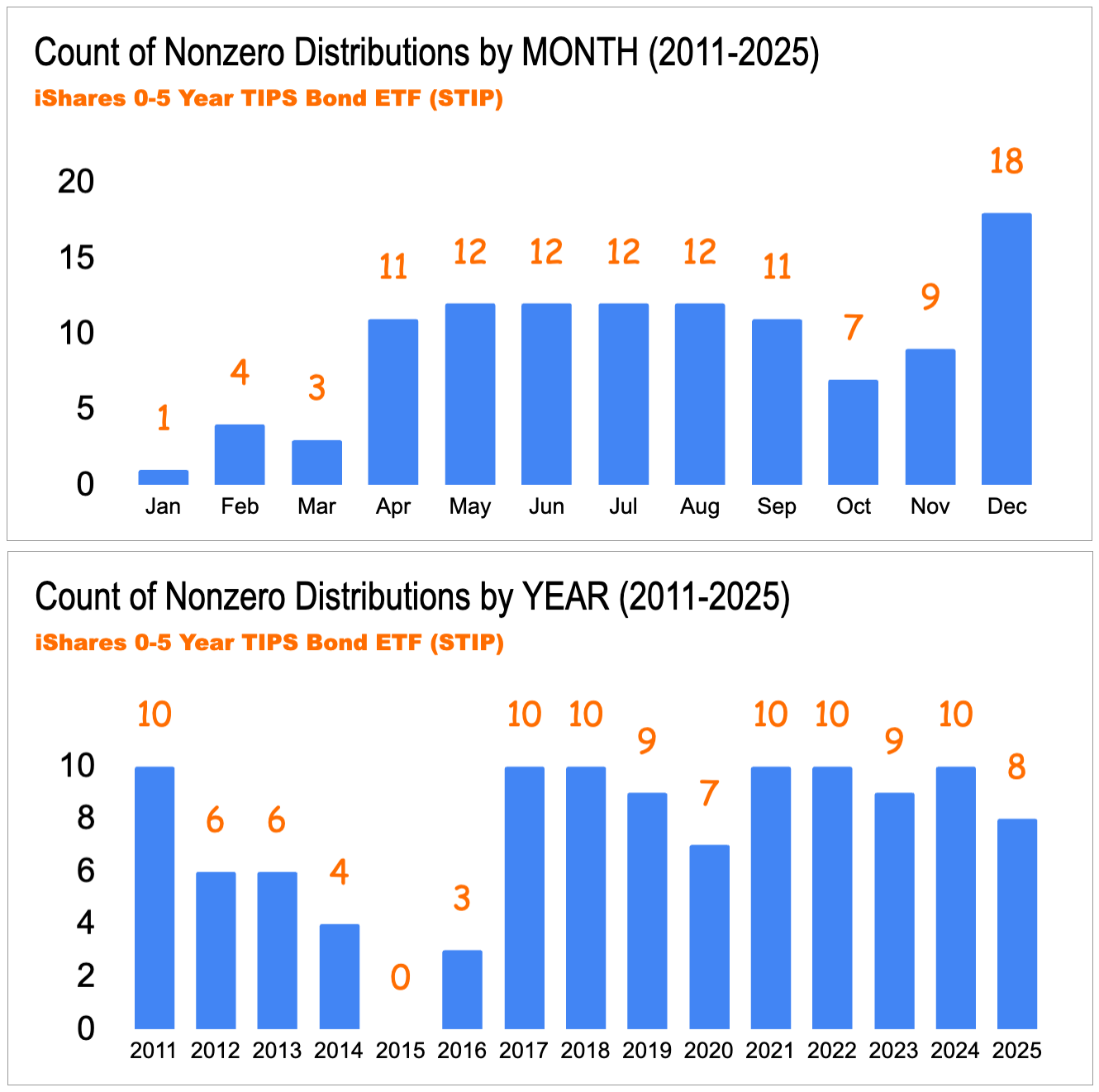TIPS taxation: the other phantom menace
Taxation without realization
👏👏 Special thanks to Elie Rozner for his superb research and writing 👏👏
TIPS coupons are taxed like regular Treasury coupons, but there’s a catch…
To begin, Treasury inflation-protected securities (TIPS) income is taxable as ordinary income and exempt from state tax.
Bond principal is adjusted per Consumer Price Index for All Urban Consumers (CPI-U). If inflation goes up, so does bond principal.
This adjustment is taxed as ordinary income even though there’s no corresponding cash flow.
That’s called phantom income. And, to abuse a joke, it’s a menace.
Off the top
TIPS are a popular asset class for hedging future consumption. Advisors often use them for retirement planning, such as by setting up a TIPS ladder to create annual real cash flows throughout retirement.
But TIPS are not like regular Treasury bonds. They have unique ways of generating income and unusual tax consequences when held in taxable accounts.
These tax consequences can cause cash flow issues, and perhaps more importantly, can upset the compounding process by creating large tax bills during big drawdowns. Let’s dive into some of the weirdness…
TIPS mechanics
TIPS have two sources of income, coupon payments and inflation adjustments.
The coupon payments are like any other Treasury coupons, with interest being paid semiannually.
The inflation adjustments are made to the bond’s principal; the principal goes up if there’s inflation, and down if there’s deflation1.
This adjustment usually takes place every six months on coupon payment dates. The principal is recalculated based on the CPI-U, and the coupon is paid based on the updated principal.
At maturity, investors either receive the adjusted principal if there was net inflation over the bond’s term, or par if there was net deflation23.
Important to note: because investors get an inflation adjustment on top of the coupon payment, the coupon rate will be much lower than that of an ordinary Treasury bond with a similar maturity4.
Here’s an example:
A $1,000 TIPS bond is issued at par on December 31, 20X0, and matures on December 31, 20X5
Interest rate: 1% annually
June 30, 20X1: first interest payment of 0.5% of the adjusted principal
Inflation rose by 1.5% over the past six months
New principal: $1,000 * 101.5% = $1,015
Interest payment: $1,015 * 0.5% = $5.075
Every 6 months, the principal is adjusted, and the updated coupons are paid
By December 31, 20X5, inflation has risen a cumulative 16% since issuance
New principal: $1,000 * 116% = $1,160
Last coupon: $1,160 * 0.5% = $5.80
The adjusted principal of $1,160 is paid to the investor along with the last coupon
Phantom menace
TIPS coupons are taxed like regular Treasury coupons. They’re ordinary income, and are exempt from state tax. Coupons are reported on 1099-INT.
The inflation adjustments to the principal are taxed each year as well, even though investors don’t receive the adjustment in cash until maturity.
These adjustments are taxed the same way as the coupons (ordinary income, exempt from state tax), but are reported on a form you’ve never heard of called 1099-OID (for Original Issue Discount). Deflation adjustments are deductible against the coupon income from that year5.
Reporting summary:
This means that if you receive $10 in coupon payments on a TIPS bond, plus $50 in inflation adjustments that you did not receive in cash, you’ll have $60 of taxable income. This is known as “phantom income.”
Phantom income shows up in a bunch of different places, both in and outside of public markets investing. Outside of public markets, one case is a partner who’s allocated a percentage of a partnership’s income for tax purposes, but receives no cash due to all the income being reinvested in the partnership.
Zero-coupon bonds are a classic case within public markets. Investors are required to recognize imputed interest income from the bond annually, even though they don’t receive cash.
TIPS are special
Phantom income is usually presented as a cash flow problem: where do I get the cash to pay the taxes on my zero-coupon bonds?
For TIPS, aside from the cash flow problem, there’s a reinvestment problem due to the timing of the inflation adjustments. Rising inflation is highly correlated with rising interest rates. Because TIPS are fixed-income instruments, their prices will fall when interest rates rise6.
This means that in an inflation shock, you’ll have a bunch of extra taxable income from your TIPS holdings, but those holdings may also be in a huge drawdown. Having that income taxed currently prevents you from reinvesting it at market lows.
Here's an extreme example of this playing out in 2022 with long-dated TIPS:
The 02/15/2048 TIPS bond had a market price of $137.75 at the beginning of 2022
It had coupon payments of ~$1.16 during the year
Inflation adjustment during the year amounted to ~$8.68
Total taxable income for 2022: $1.16 + $8.68 = $9.84
Meanwhile, the market price of the bond at the end of 2022 was $85.22, a 38% drawdown
Investors had to pay ordinary income tax on more than 10% of the bond’s year-end value, which significantly impacted their ability to reinvest, aside from cash flow issues.
ETFs to the rescue?
ETFs are required to distribute nearly all of their taxable income, including the phantom income that TIPS generate.
So, ETF sponsors typically raise cash either through direct sales of bonds in the portfolio or through cash creation with an authorized participant.
Voilà, the phantom income is now just regular cash-flow-backed income.
This solves the cash flow issue, and ETF issuers advertise as such. Here’s a table from an iShares pamphlet on their TIPS ETF.
Interestingly, some TIPS ETFs have historically distributed coupons and inflation-adjustment income inconsistently, since they are subject to the cash flows from the underlying bonds, and the vicissitudes of CPI-U, so they are a slightly weird product to use for income and tax planning.
For example, here’s STIP’s distributions by month and year going back to 2011. There’s some obvious seasonality in the monthly data (top chart) and a more obvious impact from inflation readings in the annual data (bottom chart).
Asset location, and episode II
TIPS, like many other fixed-income investments, should ideally be placed in tax-advantaged accounts. Asset location remains key.
But asset location changes if fixed income becomes more tax-efficient.
Partners Capital 2019 suggests that taxable investors should take more equity-like risk, and it looks like the ETF industry is going to deliver.
ETFs coming out of shops like F/m and Alpha Architect aim to provide exposure to traditionally tax-inefficient asset classes, but without the distributions.
F/m is doing this with their Compoundr series, which rotates in and out of other ETFs to avoid distributions. They currently have a U.S. High Yield ETF and a U.S. Aggregate Bond ETF in this series. A TIPS product could theoretically use the same approach.
Alpha Architect, known for BOXX, the ETF aiming to outperform 0-3 month Treasury bills by making active bets using various box spreads, plans to launch BOXP, which will use put-call parity to pursue outperformance of a TIPS benchmark, without the distributions.
Regardless of the implementation, investors will need to diligence possible tracking error and liquidity, among other things.
This may help some investors with planning. They simply realize capital gains (possibly paying the lower, federal long-term capital gains rate) when they need lifestyle operating capital.
TIPS could soon make the move into taxable accounts if the no-distribution ETF trend continues.
A problem, indeed
Whoops
Have a great weekend
This article is for general education. Not advice. Not a recommendation to buy or sell any security or adopt any investment strategy. Consult an adviser about your specific circumstances.
A common misconception is that the inflation adjustment is an add-on to the regular interest component. I.e., if your TIPS bond has a 1% stated coupon and inflation is 3%, you’ll get a 4% payment. In fact, you’ll still get just the 1% coupon, but the principal of the bond will be adjusted upward by 3%.
In this way, TIPS carry a built-in “put option” on deflation. Investors get the upside of net inflation adjustments, but not the downside of net deflation adjustments.
Only the repayment of par at maturity is protected from a net deflation adjustment. The semiannual interest payments, on the other hand, will always be based on the adjusted principal, even if it’s lower than par due to deflation.
Theoretically, a TIPS bond and an ordinary treasury bond with the same maturity should have roughly the same expected return. The coupon rate of a TIPS bond should therefore be the treasury coupon rate minus inflation expectations. E.g., if the 10-year treasury bond yields 4%, and inflation expectations are 3%, the 10-year TIPS should yield 1%. Because of this relationship, you could back out the market’s inflation expectations by subtracting the TIPS yield from the treasury yield.
As of the time of writing, the 10-year Treasury yield is 4.08%, and the 10-year TIPS yield is 1.70%, indicating that inflation expectations over the next 10 years stand at 4.08 – 1.70 = 2.38%. This number is referred to as the “breakeven rate,” as it’s the rate of inflation that would make you indifferent to owning bonds over TIPS and vice versa.
For more details on the deductibility of deflation adjustments, see CFR § 1.1275-7(f)(1).
This may seem counterintuitive. Aren’t TIPS supposed to hedge inflation? The answer is that they do hedge inflation, but only when held until maturity. They could vastly underperform or outperform inflation in the interim.













Thought provoking as usual, Brent. Is it safe to assume Vanguard's ETF (VTIP) avoids the phantom income trap too? I can't tell looking at their docs.